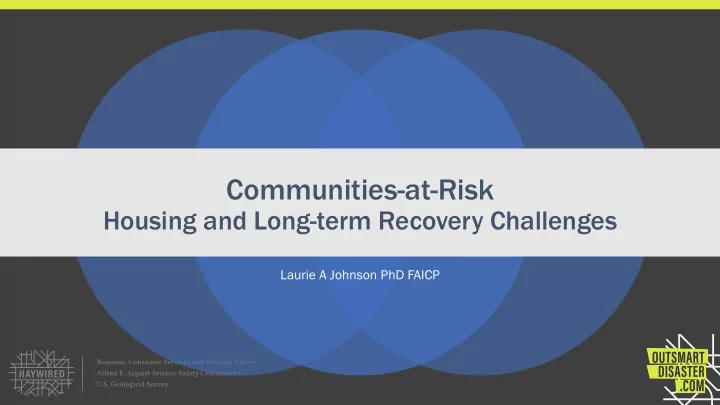

Communities-at-Risk Housing and Long-term Recovery Challenges Laurie A Johnson PhD FAICP
HayWired Damages Mainshock and Aftershock damages $72B regionwide.; $33B in Alameda County • • Extensive/Complete damage is 8% of 9 county buildings; 27% of Alameda County Population effects • 800 Deaths; 1800 injuries • 77,000-152,000 displaced households Earthquake insurance payouts • 9% of residential, 20% of commercial damages 60% insured losses in Alameda, 17% in • Santa Clara, 11% Contra Costa, <5% elsewhere Fire following Earthquake • Another $30 B in property losses Increases deaths, injuries, displacement •
HayWired Scenario – Communities-at-risk Analysis Damage Footprint and Dollars – High-impact areas were defined by combining the Hazus estimates of building damage resulting from earthquake shaking, landslide and liquefaction damage with the fire following earthquake damage Population Displacement – Consider recent studies of short- and long-term population displacement following large-scale disasters and analyze displacement risk using a range of methods – Hazus, damage footprints and utility disruptions, and socioeconomic vulnerability Long-term Community Recovery – Identify the potential long-term recovery challenges for communities and residents after a catastrophic earthquake like the HayWired Scenario Community Resilience – Highlight the spatial and systematic approach needed to build community resilience and truly realize the community-wide benefit of individual resilience efforts
Combined Hazard Exposure: Earthquake ground shaking, landslides, liquefaction and fires
Combined Damage “Footprint” Combined effects of earthquake ground Percentage of all building square footage in a shaking, landslides, liquefaction and census tract in an fires extensive or complete damage state • Nearly 1 million residential buildings >60% >60% (1.4 million housing units) and nearly 20% - 60% 20% 60% 40,000 non-residential buildings sustain damage. Almost 1/3 of Bay 10 10% - 20% 20% Area housing stock would be 2% 2% - 10 10% damaged <2% <2% • 100,000 residential buildings sustain extensive or complete damage High-impact areas cover only 8% of all census tracts in the 9-county region, but contain nearly 50% of all housing that is likely to be uninhabitable or completely destroyed and 600,000 employees
High Impact Areas: Central Alameda and Western Contra Costa counties Percentage of all building square footage in a census tract in an extensive or complete damage state >60% >60% 20% - 60% 20% 60% 10 10% - 20% 20% 2% 2% - 10 10% <2% <2%
Potential Population Displacement Househo holds Population Po Factors affecting initial and Hazus analysis of mainshock - 152,881 414,298 subsequent waves of displacement: • Direct damage and access to ground shaking and liquefaction housing only • Lifeline utility and community Integrated damage data of 267,510 719,601 service outages mainshock increased by 20% to • Environmental health effects account for long-term utility • Aftershocks outages • Social vulnerability and access to High-impact footprint for all 267,631 765,402 resources occupancies combined • Availability of interim housing High-impact footprint for single 128,543 363,315 • Availability of employment and education family/duplex dwellings Where are the receiving High-impact footprint for multi- 520,210 1,451,838 communities? family dwellings What are the rates of population Hazus analysis of aftershocks– 2,845 7,653 return and newcomers? earthquake shaking only
Social Vulnerability • 14% of Alameda County population (207,000 people) and 4% of Contra Costa County (40,000 people) reside in high- impact areas with 5 or more of the 10 community vulnerability indicators
Utilities and Transportation Disruption Electric power: 3-4 weeks Fuel: 7 -10 days (minimum) Voice and data: 7-10 days Water: up to 6 months in core damage areas Highway bridges: up to 4-10 months BART stations: up to 1-3 years Longest restoration times in Alameda, Contra Costa (water) counties Intermediate restoration times in Contra Costa, San Mateo, Santa Clara, San Francisco counties Alameda County lifeline restoration time lines
Long-Term Recovery Challenges Availability and access to recovery dollars and resources Repairing and rebuilding damaged housing Addressing areas requiring substantial re-planning and governmental intervention in order to recover Blue outlined areas have both high social vulnerability and high hazards (liquefaction, surface faulting or landslides
Opportunities to Improve Community Resilience 1. Accelerate systematic retrofit or replacement of the region’s extensive stock of seismically- vulnerable housing. 2. Set region-wide lifeline infrastructure seismic performance objectives and undertake a regionally-shared approach to prioritizing and financing upgrades to the region’s seismically- vulnerable lifeline infrastructure, especially water distribution systems. 3. Building more housing in safe locations and to modern or higher construction standards. 4. Acknowledge and address the risks that seismically-vulnerable housing and lifelines pose to communities and the region in local and regional policies. 5. Place greater emphasis on the risk of disaster-induced population displacement, especially vulnerable populations, in government, individual and business response planning, exercises, preparedness campaigns and training. 6. Plan for long-term recovery at all levels of government. 7. Understand and plan for post-earthquake recovery financing at all scales—individuals, businesses, communities, regionally, and even at the state level.
Recommend
More recommend